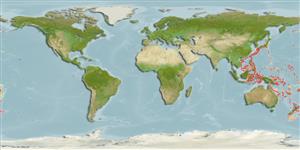Environment: milieu / climate zone / depth range / distribution range
Écologie
marin bathydémersal; profondeur 310 - 428 m (Ref. 11790). Deep-water
Western Pacific: Japan to the Kei Islands, Arafura Sea (Indonesia).
Taille / Poids / Âge
Maturity: Lm ? range ? - ? cm
Max length : 36.0 cm TL mâle / non sexé; (Ref. 9797)
Épines dorsales (Total) : 0; Rayons mous dorsaux (Total) : 65 - 70; Épines anales: 0; Rayons mous anaux: 45 - 48; Vertèbres: 30. Eyes on right side of body and very large, covered with scales on surface. Body uniformly greyish-brown, without distinct markings. Caudal fin rounded (Ref. 559).
Rare species found on mud bottoms (Ref. 9797). Feeds on benthic animals (Ref. 9797).
Life cycle and mating behavior
Maturité | Reproduction | Frai | Œufs | Fécondité | Larves
Masuda, H., K. Amaoka, C. Araga, T. Uyeno and T. Yoshino, 1984. The fishes of the Japanese Archipelago. Vol. 1. Tokai University Press, Tokyo, Japan. 437 p. (text). (Ref. 559)
Statut dans la liste rouge de l'IUCN (Ref. 130435: Version 2024-2)
Menace pour l'homme
Harmless
Utilisations par l'homme
Pêcheries: sans intérêt
Outils
Articles particuliers
Télécharger en XML
Sources Internet
Estimates based on models
Preferred temperature (Ref.
123201): 7.1 - 14.9, mean 11.1 °C (based on 47 cells).
Phylogenetic diversity index (Ref.
82804): PD
50 = 1.0156 [Uniqueness, from 0.5 = low to 2.0 = high].
Bayesian length-weight: a=0.00851 (0.00359 - 0.02015), b=3.06 (2.85 - 3.27), in cm total length, based on LWR estimates for this (Sub)family-body shape (Ref.
93245).
Niveau trophique (Ref.
69278): 3.5 ±0.37 se; based on food items.
Résilience (Ref.
120179): Milieu, temps minimum de doublement de population : 1,4 à 4,4 années (Preliminary K or Fecundity.).
Fishing Vulnerability (Ref.
59153): Low to moderate vulnerability (26 of 100).
